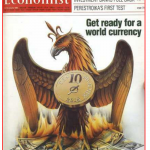 We just got more proof of our Big Reset thesis from China.
We just got more proof of our Big Reset thesis from China.
A new article written by two Hong Kong professors, Andrew Sheng and Xiao Geng, promotes the idea that the SDR could be used to reflate the global system, by issuing trillions of new SDR’s. They openly state the need for ‘a new supplementary reserve currency’ and say it ‘can be achieved without major disagreement‘.
The credentials of both academics are strong. Andrew Sheng is a distinguished Fellow of the Asia Global Institute at the University of Hong Kong and a member of the UNEP Advisory Council on Sustainable Finance, is a former chairman of the Hong Kong Securities and Futures Commission, and is currently an adjunct professor at Tsinghua University in Beijing. His latest book is From Asian to Global Financial Crisis, while Xiao Geng is a Director of the IFF Institute and a professor at the University of Hong Kong and a fellow at its Asia Global Institute.
In their Project Syndicate article they analyze the need for a monetary reset:
‘There is a growing awareness that, in today’s globalized world, financial markets are beyond the control of national policymakers. While a few economies do have the scale to shape interconnected global markets, they face serious constraints, political and economic. As a result, the global economy is stuck in a pro-cyclical financial cycle, with few options for escape.’
…..
‘With the US, the issuer of the world’s preeminent reserve currency, unwilling or unable to provide the liquidity needed to close the infrastructure investment gap, a new supplementary reserve currency should be instituted – one whose issuer does not have to confront the Triffin dilemma. This leaves one option: the International Monetary Fund’s Special Drawing Right (SDR).
Of course, the road to becoming a reserve currency is long, especially for the SDR, which currently functions only as a reserve asset, with an issuance size ($285 billion) that is small relative to global official reserves of $10.5 trillion (excluding gold). But an incremental expansion of the SDR’s role in the new global financial architecture, aimed at making the monetary-policy transmission mechanism more effective, can be achieved without major disagreement. This is because, conceptually, an increase in SDRs is equivalent to an increase in the global central bank balance sheet (quantitative easing).
Here’s how it would work. Central banks, in order to generate resources, would expand their balance sheets by investing through the IMF in the form of increased SDRs. Because SDRs comprise voting rights, they function as equity, meaning that they can be invested as such in the World Bank and other multilateral development banks, which can decide which global public goods deserve the resources. The drawdown of SDR allocations can be fine-tuned to avoid causing too much inflation.
Consider a scenario in which member central banks increase their SDR allocation in the IMF by, say, $1 trillion. A five-times leverage would enable the IMF to increase either lending to member countries or investments in infrastructure via multilateral development banks by at least $5 trillion. Moreover, multilateral development banks could leverage their equity by borrowing in capital markets. Depending on the quality of the projects, in terms of governance and cash flows, they could subsequently be sold back to investors as asset-backed securities to fund new projects.
In the past, the financial resources available for investment were constrained by national savings. In recent years, however, unconventional monetary policy has shown that liquidity and credit can be created against global savings, with relatively little impact on inflation, provided there is excess capacity in production and insufficient effective aggregate demand.
The IMF and the major central banks should take advantage of this newfound knowledge, and provide equity and liquidity against long-term lending for infrastructure investments. In this way, global public goods can be not only funded; they can also propel global recovery.’
The authors say the need for trillions of new to be created SDR’s could be ‘sold’ to the general public by using the global warming theme;
‘ An estimated $6 trillion in infrastructure investment will be needed annually over the next 15 years just to address global warming.’
While gold is not mentioned in this article we do know the Chinese haven pressured the West to study adding gold as a sixth currency to the SDR currency basket.
 We just got more proof of our Big Reset thesis from China.
We just got more proof of our Big Reset thesis from China. 
